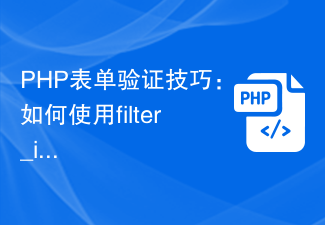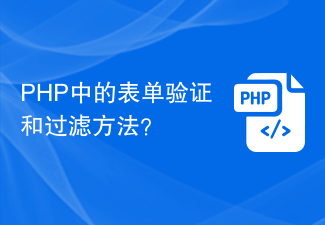 Backend Development
Backend Development PHP Tutorial
PHP Tutorial How to optimize form submission validation issues in Vue development
How to optimize form submission validation issues in Vue developmentHow to optimize form submission verification issues in Vue development
In web development, forms are one of the indispensable elements. During the form submission process, data verification is a very important task. As a popular front-end framework, Vue provides a convenient and flexible method to handle form submission verification issues. However, as the project scale increases, the processing of form validation may become complicated. Therefore, in order to improve development efficiency and optimize user experience, we need to reasonably optimize the form submission validation issue in Vue development.
1. Simplify form validation by using plug-ins
Vue provides many excellent third-party plug-ins to simplify form validation work. For example, VeeValidate and Vuelidate are two popular form validation plugins that provide a set of built-in validation rules as well as the ability to customize validation rules. These plugins provide a simple and flexible way to validate user input, which can greatly reduce the effort of manually handling validation logic.
2. Use computed properties for real-time verification
Vue’s computed properties are responsive properties that are dynamically recalculated based on dependent data. In form validation, we can use computed properties to validate user input in real time. By listening to form input, when the user inputs, the calculated properties will be recalculated and the corresponding prompt information will be returned according to the validation rules. This real-time verification method can provide immediate feedback and help users find errors and correct them faster.
3. Combining Vuex for cross-component form verification
In large projects, forms are usually used across multiple components. In order to achieve consistent validation throughout the application, we can save the form's validation status and error information in Vuex's state management. By reading and modifying these states in individual components, cross-component form validation can be easily performed. At the same time, combined with Vuex's strict mode, you can better control changes in form validation status and ensure data consistency.
4. Use custom instructions to enhance the form verification function
Vue provides the function of custom instructions. We can use this feature to enhance the form verification function. Through custom instructions, we can verify when the user inputs, and add or remove related styles, prompts, etc. based on the verification results. This method is very convenient for some special verification needs, and can improve the scalability and flexibility of form verification to a certain extent.
To summarize, optimizing form submission verification issues in Vue development mainly includes using plug-ins to simplify verification logic, using calculated properties for real-time verification, combining Vuex for cross-component verification, and using custom instructions to enhance verification functions. Through these optimization measures, development efficiency and user experience can be effectively improved, making form submission verification simpler, more reliable, and easier to maintain.
The above is the detailed content of How to optimize form submission validation issues in Vue development. For more information, please follow other related articles on the PHP Chinese website!
 如何使用Flask-WTF实现表单验证Aug 03, 2023 pm 06:53 PM
如何使用Flask-WTF实现表单验证Aug 03, 2023 pm 06:53 PM如何使用Flask-WTF实现表单验证Flask-WTF是一个用于处理Web表单验证的Flask扩展,它提供了一种简洁、灵活的方式来验证用户提交的数据。本文将向您展示如何使用Flask-WTF扩展来实现表单验证。安装Flask-WTF要使用Flask-WTF,首先需要安装它。可以使用pip命令来安装:pipinstallFlask-WTF导入所需模块在F
 php如何使用CodeIgniter4框架?May 31, 2023 pm 02:51 PM
php如何使用CodeIgniter4框架?May 31, 2023 pm 02:51 PMPHP是一种非常流行的编程语言,而CodeIgniter4是一种常用的PHP框架。在开发Web应用程序时,使用框架是非常有帮助的,它可以加速开发过程、提高代码质量、降低维护成本。本文将介绍如何使用CodeIgniter4框架。安装CodeIgniter4框架CodeIgniter4框架可以从官方网站(https://codeigniter.com/)下载。下
 Laravel开发:如何使用Laravel Validation验证表单请求?Jun 13, 2023 pm 01:34 PM
Laravel开发:如何使用Laravel Validation验证表单请求?Jun 13, 2023 pm 01:34 PMLaravel是一个流行的PHPWeb开发框架,它提供了很多方便的功能来加快开发者的工作。其中,LaravelValidation是一种非常实用的功能,它可以帮助我们轻松地验证表单请求和用户输入的数据。本文就将介绍如何使用LaravelValidation验证表单请求。什么是LaravelValidationLaravelValidation是La
 如何使用Golang实现Web应用程序的表单验证Jun 24, 2023 am 09:08 AM
如何使用Golang实现Web应用程序的表单验证Jun 24, 2023 am 09:08 AM表单验证是Web应用程序开发中非常重要的一个环节,它能够在提交表单数据之前对数据进行有效性检查,避免应用程序出现安全漏洞和数据错误。使用Golang可以轻松地实现Web应用程序的表单验证,本文将介绍如何使用Golang来实现Web应用程序的表单验证。一、表单验证的基本要素在介绍如何实现表单验证之前,我们需要知道表单验证的基本要素是什么。表单元素:表单元素是指
 PHP表单验证技巧:如何使用filter_input函数检验用户输入Aug 01, 2023 am 08:51 AM
PHP表单验证技巧:如何使用filter_input函数检验用户输入Aug 01, 2023 am 08:51 AMPHP表单验证技巧:如何使用filter_input函数检验用户输入引言:在开发Web应用程序时,表单是与用户进行交互的重要工具。而正确地验证用户输入,是保证数据的完整性和安全性的关键步骤之一。PHP提供了filter_input函数,可以方便地对用户输入进行验证和过滤。本文将介绍如何使用filter_input函数来检验用户输入,并提供相关的代码示例。一、
 PHP中的表单验证和过滤方法?Jun 29, 2023 pm 10:04 PM
PHP中的表单验证和过滤方法?Jun 29, 2023 pm 10:04 PMPHP作为一种广泛应用于Web开发的脚本语言,其表单验证和过滤是非常重要的一部分。在用户提交表单的过程中,需要对用户输入的数据进行验证和过滤,以确保数据的安全性和有效性。本文将介绍PHP中如何进行表单验证和过滤的方法和技巧。一、表单验证表单验证是指对用户输入的数据进行检查,以确保数据符合特定的规则和要求。常见的表单验证包括对必填项的验证、邮箱格式、手机号码格
 ThinkPHP6如何进行表单验证操作?Jun 12, 2023 am 09:36 AM
ThinkPHP6如何进行表单验证操作?Jun 12, 2023 am 09:36 AMThinkPHP6是一款基于PHP的MVC框架,极大地简化了Web应用程序的开发。其中表单验证是一个非常基础和重要的功能。在这篇文章中,我们将介绍ThinkPHP6中如何进行表单验证操作。一、验证规则定义在ThinkPHP6中,验证规则都需要定义在控制器中,我们可以通过在控制器中定义一个$validate属性来实现规则的定义,如下所示:usethinkVa
 Golang学习之Web应用程序的表单验证实践Jun 24, 2023 pm 03:07 PM
Golang学习之Web应用程序的表单验证实践Jun 24, 2023 pm 03:07 PM在Web开发中,表单验证是一个极其关键的部分。表单验证可以有效地保护数据的安全性,防止非法用户的攻击和恶意操作。在Golang中,表单验证技术也应用广泛,特别是在Web应用程序中。本文将介绍Golang中Web应用程序的表单验证实践。一、表单验证的基本原理在Web应用程序中,表单验证的基本原理是在Web页面提交数据之前进行数据的检查和验证。这些数据可能是用户


Hot AI Tools

Undresser.AI Undress
AI-powered app for creating realistic nude photos

AI Clothes Remover
Online AI tool for removing clothes from photos.

Undress AI Tool
Undress images for free

Clothoff.io
AI clothes remover

AI Hentai Generator
Generate AI Hentai for free.

Hot Article

Hot Tools

PhpStorm Mac version
The latest (2018.2.1) professional PHP integrated development tool

DVWA
Damn Vulnerable Web App (DVWA) is a PHP/MySQL web application that is very vulnerable. Its main goals are to be an aid for security professionals to test their skills and tools in a legal environment, to help web developers better understand the process of securing web applications, and to help teachers/students teach/learn in a classroom environment Web application security. The goal of DVWA is to practice some of the most common web vulnerabilities through a simple and straightforward interface, with varying degrees of difficulty. Please note that this software

SecLists
SecLists is the ultimate security tester's companion. It is a collection of various types of lists that are frequently used during security assessments, all in one place. SecLists helps make security testing more efficient and productive by conveniently providing all the lists a security tester might need. List types include usernames, passwords, URLs, fuzzing payloads, sensitive data patterns, web shells, and more. The tester can simply pull this repository onto a new test machine and he will have access to every type of list he needs.

Safe Exam Browser
Safe Exam Browser is a secure browser environment for taking online exams securely. This software turns any computer into a secure workstation. It controls access to any utility and prevents students from using unauthorized resources.

MinGW - Minimalist GNU for Windows
This project is in the process of being migrated to osdn.net/projects/mingw, you can continue to follow us there. MinGW: A native Windows port of the GNU Compiler Collection (GCC), freely distributable import libraries and header files for building native Windows applications; includes extensions to the MSVC runtime to support C99 functionality. All MinGW software can run on 64-bit Windows platforms.





